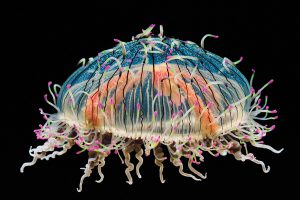How did life begin? This question has preoccupied humankind for thousands of years, perhaps from the time of the emergence of consciousness, paving the way for religion, which postulated a god or divine being. However, the Greek thinkers Thales of Miletus (624-546 B.C.) and Anaximander (611-546 B.C.E.) didn’t believe in these supernatural forces and came up instead with a general scientific world view. Their ideas were further developed by later thinkers such as Greek philosopher Aristotle (384-322 BCE) and German philosopher Immanuel Kant (1724–1804), and then by 19th Century evolutionists such as Charles Darwin. Today, there are several competing scientific theories, which experts try to prove (or disprove) with the help of the Large Hadron Collider. While many still believe it could only have happened through the intervention of a supreme being, others, such as astrophysicist Stephen Hawking, believe time started at the moment of singularity, so that there was no time before the Big Bang for a god to create the universe.
That is something to keep in mind when viewing Dutch photographer Frans Lanting’s fascinating exhibit, Life: A Journey Through Time, currently at the Annenberg Space for Photography. The seven-year project, realized with the help of his partner, Christine Eckstrom, is more than merely a series of nature and wildlife images. The exhibition embodies Lanting’s photographic interpretation of life on Earth from the Big Bang to its present diversity, embracing a scientific viewpoint. Included are more than 70 images and a documentary film with comments by Lanting, biologist E.O. Wilson, and Mars Program Chief Scientist Richard Zurek, as well as other experts. It also contains two videos of Lanting’s TED talks and a six-minute film presenting the photographer’s images choreographed to the music of composer Philip Glass.

Volcano at dawn, Hawaii, USA © Frans Lanting/www.lanting.com
The exhibit is divided in seven parts. It opens with “Elements,” introduced by a poem by Lanting and photos of his interpretation of Earth’s early history, before life. Hence, images of a volcano at dawn in Hawaii, a waterfall in Brazil, and the Sun shining through a group of icicles in Antarctica, hinting at the five classical elements: earth, air, fire, water, and space. The theme, “Beginnings,” itself begins with an image of a Geyser at dawn in Nevada, shot with a strobe that illuminates the green strand of cyanobacteria growing on its dome and spewing boiling water into the morning sky. “Cyanobacteria were the first life forms to convert sunlight and water into energy through photosynthesis, releasing oxygen as a by-product,” Lanting explains. The section also includes images of stromatolites, diatoms, fossils, ocean jellies, and schooling fish.
“Out of the Sea” is devoted to life as it went ashore, suggested by photos of a whisk fern in Hawaii, a land snail in California, and a leatherback sea turtle in Surinam. For “On Land,” Lanting and Eckstrom travelled to the Galapagos Islands, stepping into the footsteps of Darwin, shooting giant tortoises by moonlight to represent an epoch dominated by reptilian giants. “I wanted to make each image true to a certain period of time without showing anything that evolved later on,” Lanting says. From there, the story takes off with “Into the Air,” first featuring a photo of a frigate bird with its wings flapping in twilight, symbolizing the time when reptiles became capable of flight and pterosaurs were still around. Other photos of exotic birds and flowers include images of a hummingbird feeding on a ginger flower and water lilies spreading their leaves to absorb light from the sun. These pictures stress the beauty wiped out when an asteroid hit the earth about 65 million years ago, causing mass extinction.
The show shifts to “Out of the Dark,” focusing on the era of the rise of mammals with a series of stunning photographs: a jumping kangaroo in Australia, zebras grazing in the grasslands of Kenya, an elephant and an antelope standing peacefully side by side, while sipping water at a lake in Botswana. At the very end, a photo of a chimpanzee hangs next to the image of a human fetus, implying the evolution from ape to man. The exhibition closes with “Planet of Life,” showing Lanting’s vision of the collective force of life as a sixth element, inspired by James Lovelock’s Gaia theory.
Whether or not we agree with Lanting’s vision and the theories he touches upon, his exhibit makes us aware of our fragility and of how precious our planet and its life are.
Life: A Journey Through Time
October 24, 2015—March 20, 2016
Annenberg Space for Photography
2000 Avenue of the Stars, Los Angeles, CA 90067













